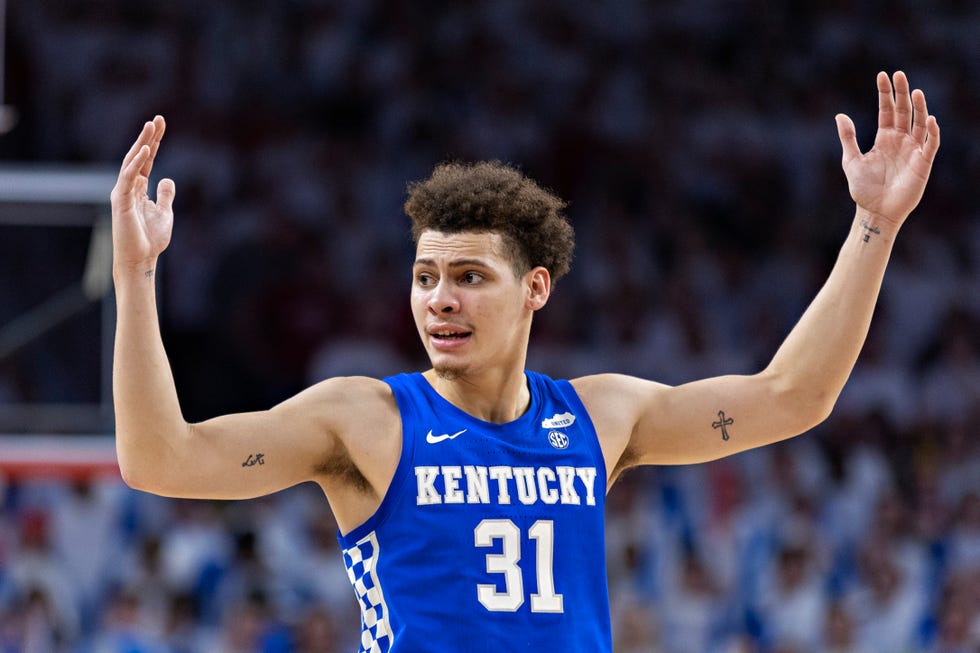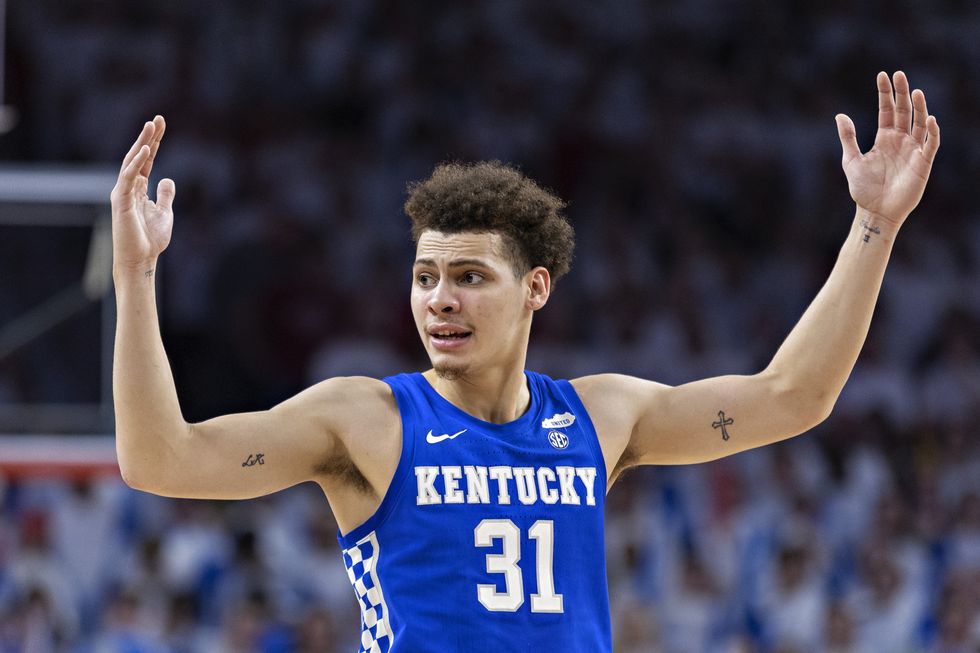
It’s that time of year again: March Madness. There’s something special and exciting about college basketball—hence why it completely takes over the sports world every spring for the NCAA tournament. Maybe it’s that fans have a personal connection to the schools or viewers are more engaged because of their brackets. Either way, all eyes are on these players when the tournament rolls around—but it’s not always easy for them. There are rules that come along with being a Division I athlete. From halftime snacks to dress codes, find out what college basketball players can or can’t do if they want to play the game.
1
Blood from an injury must be cleaned up ASAP.
Players have exactly 20 seconds to take care of anything from a badly scraped knee to a bloody nose, otherwise they have to leave the game. The rule also applies to an irritated (or lost) contact lens.
2
No jersey number can end in 6, 7, 8, or 9.
The NCAA only offers players a total of 37 jersey numbers to choose from—and none of them include 6, 7, 8, or 9. Why? Those digits require two hands to sign, which complicates things for referees.
3
Don’t pick up your teammates.
We’d file this one under things that should be able to go unsaid, but there’s an actual rule that states “climbing on or lifting a teammate to secure greater height” is not allowed.
4
Benched players have to remain seated.
Well, most of the time. The one exception in the rule book? “To spontaneously react to an outstanding play, immediately sitting down on the bench afterwards.”
5
No jewelry can be worn during the game.
This is a safety concern. If your team wins, you can rock your finest jewelry at the afterparty—just not on the court.
6
You have to tuck in your jersey.
Both the men’s and women’s leagues follow the same rule to 1. Stop sweat from dripping onto the court. 2. Prevent injuries, like tripping over loose fabric or catching yourself on an opponent. 3. Give players more movement while shooting a ball.
7
Long fingernails are also a no-go.
8
You have to be tall.
Okay, okay, this isn’t exactly a rule, but it definitely helps. In NCAA Division 1, the average male player is just under 6’5″, while the average female player is 5’6″.
9
You must maintain a certain GPA.
Division I students must earn at least six credit hours each term and meet their school’s GPA requirement for graduation. They also have to complete 40 percent of their degree by the end of the second year, 60 percent by the end of the third year, and 80 percent by the end of the fourth year.
10
Homework has to be done on the road.
Many teams travel with an adviser who’s responsible for keeping players on track academically, with tutoring and helping set studying schedules. “That’s what the coaches sell to their parents and to them on recruiting visits, that we will be doing homework on the road,” Xavier University’s assistant director of student-athlete academic support services, Chris Barbour, told WCPO.
11
You have to fly coach…sometimes.
During the regular season, it’s up to the schools to decide how they want their students to travel—some spend big bucks on private planes, while others fly coach.
12
Living with teammates is not required.
But who wouldn’t want to live with peers who have the same busy schedule as you? A whopping 60 percent of men’s Division I basketball players live exclusively with teammates.
13
Don’t expect special dorm rooms.
These best players might be on the road to the NBA, but they won’t be treated like LeBron James just yet. Even if universities build housing specifically with student athletes in mind, NCAA rules “require that residence halls for student-athletes house at least 51 percent general population students and not offer special treatment to athletes.”
14
But there are some perks.
In 2021, the Supreme Court sided with student athletes over the NCAA in a case about educational benefits. Now, schools can recruit players with just about anything, as long as it’s tied to education. A former top NCAA official, Oliver Luck, told NPR that could mean a year abroad, internships, law or medical school tuition, and more.
15
You get unlimited meals.
16
You can refuel at halftime.
Eating simple or “quick” carbs—ones that can be digested easily—is key to feeling ready to take on the second half of a game. It’s common for players to scarf down a snack during halftime. For Duke, peanut butter and jelly sandwiches are a team favorite.
17
Being paid to play in the past makes you ineligible.
Why? The NCAA tries to keep amateurism in the sport. Internationally, things work differently and many teens grow up being paid by clubs. When they reach college age and apply to top U.S. universities, many are ineligible.
18
You have to have completed high school in four years.
In a sad turn of events, Colorado freshman Evan Battey was ruled academically ineligible by the NCAA for the 2017-18 season after it was found he repeated the ninth grade. He took a redshirt year and was able to practice with the team, but not compete or travel.
19
But college can take more than four years.
The NCAA offered a “free year” to athletes because of the COVID-19 pandemic and disrupted 2020-21 season. Because of that, super seniors are becoming more comm
